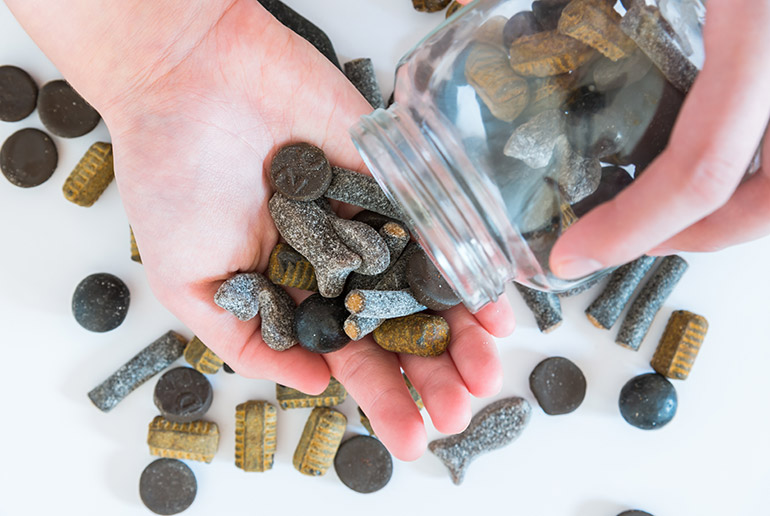Yummy or yuk? Salt licorice is a uniquely Scandinavian ‘treat’ that you’ll either love or hate.

With its strong salty flavour and distinctive tang, this confectionery sensation, also known as salmiakki, divides opinions like no other candy we’ve ever tried.
Whether you fall head over heels for its chewy allure or cringe at its intense saltiness, one thing is certain: salty licorice is worth trying at least once.
A Scandi candy unlike any other
But what is salty licorice and what sets it apart from regular old licorice? Well, it’s a distinctive type of candy that originates from the Nordic countries, particularly Sweden and Finland.
Unlike the familiar sweet licorice found in the UK or USA, salty licorice combines the bold taste of licorice root extract with a surprising salty, savoury twist.
This intriguing flavour combination is achieved by incorporating ammonium chloride into the licorice recipe (rather than regular table salt, or sodium chloride).
The inclusion of this salty ingredient gives the licorice a strong, bracing note that can range from mildly tangy to intensely salty, creating a polarising taste that some people love, and other want to get away from as soon as humanly possible.
Salty licorice comes in various forms, including chewy candies, soft or hard candies, and even licorice-flavoured chocolate.
The great salmiakki divide: love it or hate it
Salty licorice is a candy that people either love or hate, with strong opinions on both sides. Some folks really enjoy its intense taste and can’t get enough, while others can’t stand it and may even feel sick.
The reason for this division is the particular taste combination.

Those who love it appreciate the bold and contrasting flavours that excite their taste buds. Those who dislike it find the salty taste overpowering and different to what they expect from licorice.
This disagreement in preferences shows how taste can vary greatly and makes salty licorice all the more intriguing.
The best Nordic salt licorice brands to try
Want to try it for yourself? Explore the world of Nordic salty licorice with these famous brands. To make things nice and easy, we’ve divided them up by the countries where they’re made.
Norway
Nidars IFA
IFA is a classic option from Norway. It was first introduced in 1930 and has since become one of the country’s most popular salty licorice options. If you’re looking for the perfect mix of sweet and salty, definitely opt for IFA!
Brynhild Dunder Salt and Salmiakk
Another popular Norwegian brand, Dundersalt (thunder salt) delivers a rich and invigorating salty licorice experience.
Sweden
Malaco Djungelvrål
One of the most popular brands in Sweden, and one of the most nostalgic as well. Malaco Djungelvral has been enjoyed by Swedes for generations. If you really want to go in at the deep end, this is a nice one to start with.
Bubs Salt Skalle
Not only do Swedes love their saltlakrits, but they also love candies in the shape of skulls. And Salt Skalle is the perfect candy if you crave a combination of both.
Finland
Tyrkisk Peber
Tyrkisk Peber is one of the most famous salt licorice brands and is perfect for those seeking a fiery punch. It delivers an exhilarating tang, with a spicy-salty pepper flavour that almost burns your tongue when the spicy powder in the middle is released.
Fazer Salmiakki
Known for its high-quality ingredients, robust aroma and authentic taste, Fazer Salmiakki has a devoted following both within Finland and abroad.

Denmark
Nordic Sweets Salmiac Stix
Salmiac Stix presents a delightful twist on salty licorice. These slender licorice sticks are infused with salmiak salt, providing a satisfying and intense flavour.
Toms BonBon Lossepladsen Mix
BonBon Lossepladsen Mix offers a great introduction to the world of salty licorice.
This mix provides a variety of candies, including some with a hint of saltiness, allowing newcomers to experience the distinctive taste of salty licorice in a balanced and approachable way.
Is salty licorice actually good for you?
Licorice root is known for having health benefits, with some claiming that it can reduce gastric inflammation and even help reduce stress.
However, when it comes to salty licorice, the situation is more complex. While licorice root itself may have potential health advantages, the other ingredients can pose concerns.
Obviously, the salt content in salty licorice is a key factor to consider when evaluating its potential impact on health.

Excessive salt intake is generally linked to hypertension, and individuals who are already susceptible to high blood pressure should be cautious about consuming salty licorice regularly.
Additionally, glycyrrhizin, a compound found in licorice root extract, can have an impact on blood pressure as well.
Large quantities or prolonged consumption of glycyrrhizin have been associated with increased blood pressure and other potential adverse effects.
Furthermore, it’s important to consider the stickiness and high sugar content often present in salty licorice.
The stickiness can contribute to dental issues, as it allows harmful bacteria to cling to teeth, potentially leading to cavities.
Moreover, the high sugar content further adds to the risk of tooth decay and negatively affects overall sugar intake.
Another point of concern is the perceived toxicity associated with salty licorice due to the presence of ammonium chloride.
However, when consumed in regulated amounts, ammonium chloride is widely considered safe.
Overall, when considering the potential impact on health, it is important to acknowledge that salty licorice may not be the healthiest choice. Moderation is key when enjoying this Scandi treat!
Beyond candy: salty licorice flavours in everyday products
Salty licorice isn’t just limited to candy. It has found its way into a variety of everyday Scandinavian products, adding a unique twist to the mundane.

Imagine brushing your teeth with licorice-flavoured toothpaste or indulging in a scoop of salty licorice ice cream on a sunny day.
If that’s not enough, you can can even get licorice-flavoured chewing gum.
And for those who partake in snus, a type of smokeless tobacco, there’s even salty snus with licorice undertones.
Experience salty licorice in Scandinavia: from candy stores to hotels
So if you fancy giving salty licorice a try, Scandinavia is brimming with fantastic places to satisfy your salty licorice cravings.

You’re almost guaranteed to find them in any local grocery store or supermarket, while specialist candy stores or confectionery shops often have a dedicated section for licorice, including the salty variety.
Lakritsroten has several stores in Sweden, including in Stockholm, Gothenburg and Malmö, where you can buy a selection of licorice delights. It also sells online.
In Oslo, Norway, Yummy Heaven sells a wide array of candies and treats, including different tempting types of salty licorice.
And the Danish chain Lakrids by Bülow, which makes all kinds of licorice sweets, is sold in stores across Scandinavia and beyond, including in the UK and US.
Easy homemade Scandinavian salt licorice recipe
Why not try your hand at making your own salty licorice? With a few simple ingredients and a little bit of creativity, you can create a batch of this yummy treat, tailor-made to suit your taste preferences.
Ingredients:
- 1/2 cup of water
- 1 cup of sugar
- 1/2 cup of golden syrup or molasses
- 1 tablespoon of licorice root powder
- 1/2 teaspoon of sea salt
- 1 tablespoon of anise or fennel oil
- 1/2 cup of gelatin (you could use agar agar for a vegetarian version)
- Extra sea salt for coating
Instructions:
- Preparation: Gather all your ingredients. Line a baking dish with parchment paper and set it aside.
- Making the syrup: In a medium-sized saucepan, combine the water, sugar and golden syrup (or molasses). Bring it to a simmer over medium heat. Stir until the sugar is fully dissolved.
- Adding flavours: Add the licorice root powder, sea salt and anise or fennel oil into the saucepan. Stir well to combine all the ingredients.
- Adding the gelatin: Sprinkle the gelatin into the saucepan while continuously stirring to prevent clumping. Continue to stir until the gelatin is fully dissolved.
- Pour and set: Once everything is well combined and smooth, pour the mixture into the prepared baking dish. Allow it to set in the refrigerator for at least 2 hours, or until it is fully firm.
- Cutting and coating: Once the mixture is firm, remove it from the refrigerator. Cut the licorice into bite-sized pieces, and roll each piece in some extra sea salt.
- Storage: Store the licorice in an airtight container at room temperature. It should keep for up to two weeks.
See also:
Danish smørrebrød: the ultimate guide
What is a Swedish smörgåsbord?
All you need to know about Swedish fish









